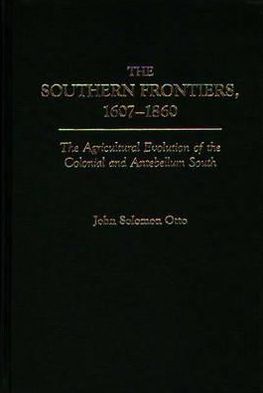

 |

|

The average rating for The Southern Frontiers, 1607-1860: The Agricultural Evolution of the Colonial and Antebellum South based on 2 reviews is 3 stars.
Review # 1 was written on 2008-12-30 00:00:00 Tomas Mens Tomas MensI read this because I have been trying to educate myself as to the history of the native Ojibwe (Chippewa) in my community. It was fun to read references to places I know and have visited as the move of Europeans (who wrote the early travelogues and diaries) into the area was discussed. Especially fun was the discussion on pp 100-104 of the Northwest and XY companies and their posts on the Yellow River'now a living history museum in "our neck of the woods." In the beginning, the Europeans were entirely dependent on the locals, but the locals soon became accustomed to the trade goods the Europeans brought (especially the alcohol) and dependency shifted in ways that completely undermined the local culture. Wyman does not document the injustices done the natives like Brown does in Bury My Heart at Wounded Knee, but the fact that it was their land and we took it is quite obvious. All treaties were made from a position of military strength on the part of the British or Americans (not so much the French, who never really colonized, but only made forays into the area for trade); the Indians could dispute the terms, but not the fact that they were being forced out. By the end, removal sounded much like Apartheid South Africans removing blacks to "homelands," i.e. the land no white person wanted. Apparently the Ojibwe remain in my community primarily because we are too far north for a decent growing season, and the soil is not good enough for farming. That and they were stubborn and returned home every time the government tried to move them to Minnesota. ☺ Stories of abuse passed down on both sides fed prejudice. Shared experiences softened it, but couldn't overcome all attitudes. In the post-Civil War era, some whites made the connection that if blacks could be citizens, Indians should with the result of a movement to defend their right to return to their home state of Wisconsin. But this was a pretty paternalistic attitude that Indians should assimilate, becoming just like their white neighbors. In order to do that, each Indian needed his own land to free them from the rule of chiefs, i.e. American individualism rather than community working together. Of course, taking control away from the community meant that soon 90% of reservation land passed into non-Indian hands. The pre-European reality was not idyllic. Life was hard, hence the welcome to European trade goods like steel knives, iron pots, and blankets. Warfare, especially between the Chippewa and the Sioux, was common. Winnebagos seem to have been cannibals. This book brings the problem closer to home, but it definitely softens the indignities. The most destructive thing whites did seems to have been the introduction of alcohol, a continuing problem passed from generation to generation. This book brings me a step closer to understanding local realities. Now I think I need to find out what there is on local history besides Forts Folle Avoine. |
Review # 2 was written on 2015-11-05 00:00:00 Stephen Jordan Stephen JordanThe early history of the great state of Wisconsin is one of abundance and eradication. When the first European explorers arrived, Wisconsin was a virtual El Dorado of natural resources -- pine forests covered the north, hardwoods much of the south. The woodlands teemed with elk, cougar, beaver, caribou, martens and fisher. Rich veins of lead could be found just below the topsoil in parts of the state. Thunderous herds of bison roamed the prairies of Wisconsin's southwest and clouds of passenger pigeons darkened the endless skies. Within a hundred and 25 years of America's indepence -- 50 years after Wisconsin's statehood -- though, most of it was gone. Trappers and hunters harvested most fur and game animals into virtual oblivion. The lead mines were abandoned, their riches depleted. Frederick Weyerhaeuser and his fellow timber barons stripped the landscape of its mighty red and white pine, leaving a barren wasteland of scrub and slash, ripe for "natural" disaster like the Great Peshtigo Fire of 1871. Mark Wyman's 1998 book "The Wisconsin Frontier" is the story of those early years. His meandering narrative tells the tale of the early explorers and then settlers who were both awed by Wisconsin's beauty and abundance, and at the mercy of its harsh elements. He combines countless facts, characters, places and dates with a lively and compelling writing style. The result is a fascinating read, well worth the considerable time it takes to get through. The only quarrell I have with Wyman's narrative is the way he treats Hamlin Garland and Frederick Jackson Turner. Both Wisconsin natives played a major role in changing the way history portrayed the American frontier. Both were prime movers in the transition from Romanticism to Realism, and yet both are relegated to a minor sub-chapter at the end of the book. Their stories and their influence merits considerably more than a literary afterthought. Wyman's book would have only a sad, sad ending were it published 100 years earlier. Fortunately for those of us blessed to live in Wisconsin in the latter part of the 20th century, however, the opposite is true. Thanks to the resiliency of Wisconsin's wilderness, and the resolve of her people, much that once was is restored. One need only set out on US Rt. 51 North from Beloit and take a day's drive to Hurley to behold the amazing beauty that is Wisconsin today. |
CAN'T FIND WHAT YOU'RE LOOKING FOR? CLICK HERE!!!